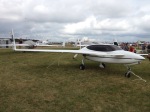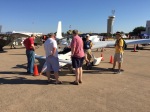Links
- Start on the Canard Wikipedia page for a good wiki dive.
- Burt Rutan’s official site and Stargazer, a ridiculously detailed look at his designs.
Photos
Full Transcript
There’s something you need to know about me.
I like airplanes.
A lot.
And airships and spaceships and helicopters and … yeah you get the picture.
And while I like airplanes in general, I have a special place in my heart for the weird ones. The misfits. The ones that make you wonder “how exactly is this thing flying?”
I also really like individual bits and pieces of airplanes, especially the weird ones.
I want to tell you about one of those weird pieces of airplanes, but it’s not on all airplanes and come to think of it not very many airplanes. It’s called a canard.
A canard is a small wing thing that goes in front of the main wing of an airplane, instead of the usual configuration with a main wing somewhere in the middle and a tail in the back doing things like stabilizing and controlling the airplane.
Canards actually had a lot going for them in the early days of aviation. The Wright Flyer, a little airplane you might remember from that thing it did in Kill Devil Hills on December 17, 1903 — was actually a canard biplane. But like steering by warping the wings, canards never really went mainstream.
The term canard actually comes from French folks, who thought early airplanes like Alberto Santos-Dumont’s quatorze-bis and Henri Fabre’s Hydravion kind of looked like the bill of a duck, with that wing sticking out in front.
After the early days though you don’t see a ton of canards except for experiments here and there. This really continues through both world wars, and canards don’t really see a ton of love until the jet age in planes like the XB-70 Valkrye, this crazy Mach 3 experimental bomber and the Saab 37 Viggen, a single seat fighter, attack, and recon plane.
Backing up a bit, a canard can actually do lots of different things. It can help control an airplane, like the Wright Flyer or the Eurofighter Typhoon. It can also act like a horizontal stabilizer. It is often used to stabilize fly-by-wire fighters, where you actually want a fairly unstable airplane in order to remain supermaneuverable. Sometimes it eliminates the need for a traditional tail altogether, other times it’s part of a three-surface configuration like the super sweet pusher turboprop Piaggio Avanti.
It can also be used to provide additional lift. This is the way that it’s often used in smaller experimental airplanes.
Okay, timeout. We’re talking about experimental aircraft and canards. It’s time to introduce you to Burt Rutan.
Burt Rutan is a prolific aircraft designer. He’s thought up over 350 aircraft designs and worked on 45 enough that they fly. His first design, the VariViggen, sported a canard. He’s designed a bunch of other unconventional aircraft that you might recognize. He designed the Voyager and GlobalFlyer nonstop around-the-world aircraft. He designed SpaceShipOne and SpaceShipTwo, the beautiful Beechcraft Starship, and hundreds more.
I’m a huge fan of his EZ family of small experimental homebuilts including the Vari-Eze and the Long-EZ. They’re lightweight made from fiberglass or carbon fiber. With a pusher engine in back, you actually collapse the front landing gear and park them on their nose, otherwise they’d fall over backwards.
This is Matt Croydon and you are listening to The Tinycast.
Music for today’s show includes We Always Thought the Future Would Be Kind of Fun, Prelude 16, The Temperature of the Air on the Bow of the Kaleetan, and Divider by Chris Zabriskie. You can find him at chriszabriskie.com or on Band Camp.
We are on the web at tinycast.in where you can check out links and pictures of airplanes with canards from my photostream. We’re on twitter @thetinycast, soundcloud.com/tinycast and the iTunes Podcast Directory. Episodes are also available at the Public Radio Exchange, PRX.org.



